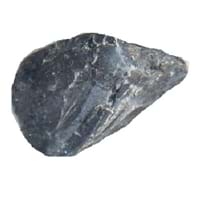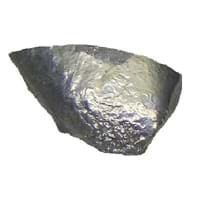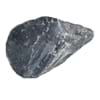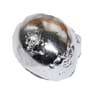Barium vs Iridium
Periodic Table
Symbol
Ba
Ir
Group Number
2
16
9
9
Period Number
6
6
Block
s block
d block
Element Family
Alkaline Earth
Transition Metal
CAS Number
7440393
99+
7439885
99+
Space Group Name
Im_ 3m
Fm_ 3m
Space Group Number
229.00
1
225.00
2
Facts
Interesting Facts
- Barium oxidizes very easily in the air.
- All toxic compounds of Barium can easily dissolve in water.
- Barium carbonate is used to produce a Rat poison and its other compound Barium nitrate is used in fireworks to produce green color.
- Iridium element occurs as natural alloys of Platinum and Osmium.
- Iridium element is known as the most corrosion resistance metal .
Sources
Earth's crust, Found in Minerals, Mining, Ores of Minerals
Found in Minerals, Mining, Ores of Minerals
History
Who Discovered
Carl Wilhelm Scheele
Smithson Tennant
Discovery
In 1772
In 1803
Abundance
Abundance In Universe
1 * 10-6 %
16
2 * 10-7 %
22
Abundance In Sun
~0.000001 %
18
~0.0000002 %
25
Abundance In Meteorites
0.00 %
20
0.00 %
29
Abundance In Earth's Crust
0.03 %
11
0.00 %
99+
Abundance In Oceans
0.00 %
8
Not Available
Abundance In Humans
0.00 %
12
Not Available
Uses
Uses & Benefits
- It is sued in chemical paint manufacturing and glass manufacturing.
- Compounds of this metal are toxic; but still the barium sulfate is insoluble and given to patients suffering from digestive disorder.
- Iridium has an anti corrosion properties and it is used in special alloy with Osmium metal and that alloy is used in pen tips and compass bearings.
Industrial Uses
Ammunition Industry, Automobile Industry, Electrical Industry, Electronic Industry
Automobile Industry, Electrical Industry, Electronic Industry
Medical Uses
NA
NA
Other Uses
Alloys
Alloys
Biological Properties
Toxicity
Low Toxic
Toxic
Present in Human Body
Yes
Yes
In Blood
0.07 Blood/mg dm-3
15
Not Available
In Bone
70.00 p.p.m.
9
Not Available
Physical Properties
Melting Point
725.00 °C
99+
2,410.00 °C
7
Boiling Point
1,140.00 °C
99+
4,527.00 °C
10
Appearance
Physical State
Solid
Solid
Color
Silvery Gray
Silvery White
Luster
NA
Metallic
Hardness
Mohs Hardness
1.25
19
6.50
5
Brinell Hardness
Not Available
1,670.00 MPa
5
Vickers Hardness
Not Available
1,760.00 MPa
3
Speed of Sound
1,620.00 m/s
99+
4,825.00 m/s
13
Optical Properties
Reflectivity
Not Available
78.00 %
6
Allotropes
No
No
α Allotropes
Not Available
Not Available
β Allotropes
Not Available
Not Available
γ Allotropes
Not Available
Not Available
Chemical Properties
Chemical Formula
Ba
Ir
Isotopes
Known Isotopes
37
2
34
5
Electronegativity
Pauling Electronegativity
0.89
99+
2.20
4
Sanderson Electronegativity
0.68
28
Not Available
Allred Rochow Electronegativity
0.97
38
1.55
11
Mulliken-Jaffe Electronegativity
0.88
22
Not Available
Allen Electronegativity
0.88
99+
1.68
17
Electropositivity
Pauling Electropositivity
3.11
4
1.80
99+
Ionization Energies
1st Energy Level
502.90 kJ/mol
99+
880.00 kJ/mol
9
2nd Energy Level
965.20 kJ/mol
99+
1,600.00 kJ/mol
35
3rd Energy Level
3,600.00 kJ/mol
14
Not Available
Electrochemical Equivalent
2.56 g/amp-hr
20
1.14 g/amp-hr
99+
Electron Work Function
2.70 eV
99+
4.55 eV
13
Other Chemical Properties
Ionization, Radioactive Isotopes, Radioactivity, Solubility
Flammable, Ionization, Radioactive Isotopes, Radioactivity
Atomic Properties
Atomic Number
56
99+
77
39
Electron Configuration
[Xe] 6s2
[Xe] 4f14 5d7 6s2
Crystal Structure
Body Centered Cubic (BCC)
Face Centered Cubic (FCC)
Crystal Lattice
BCC-Crystal-Structure-.jpg#100
FCC-Crystal-Structure-of-Iridium.jpg#100
Atom
Number of Protons
56
99+
74
99+
Number of Neutrons
81
99+
110
27
Number of Electrons
56
99+
74
99+
Radius of an Atom
Atomic Radius
222.00 pm
4
136.00 pm
99+
Covalent Radius
215.00 pm
5
141.00 pm
99+
Van der Waals Radius
268.00 pm
6
202.00 pm
27
Atomic Weight
137.33 amu
99+
192.22 amu
34
Atomic Volume
39.24 cm3/mol
5
9.53 cm3/mol
99+
Adjacent Atomic Numbers
Valence Electron Potential
21.30 (-eV)
99+
140.00 (-eV)
5
Lattice Constant
502.80 pm
15
383.90 pm
26
Lattice Angles
π/2, π/2, π/2
π/2, π/2, π/2
Lattice C/A Ratio
Not Available
Not Available
Mechanical Properties
Density
Density At Room Temperature
3.51 g/cm3
99+
22.56 g/cm3
10
Density When Liquid (at m.p.)
3.34 g/cm3
99+
19.00 g/cm3
3
Tensile Strength
Not Available
2,000.00 MPa
2
Viscosity
Not Available
Not Available
Vapor Pressure
Vapor Pressure at 1000 K
7.11 (Pa)
6
Not Available
Vapor Pressure at 2000 K
Not Available
0.00 (Pa)
25
Elasticity properties
Shear Modulus
4.90 GPa
99+
210.00 GPa
2
Bulk Modulus
9.60 GPa
99+
320.00 GPa
3
Young's Modulus
13.00 GPa
99+
528.00 GPa
1
Poisson Ratio
Not Available
0.26
22
Other Mechanical Properties
NA
NA
Magnetic Properties
Magnetic Characteristics
Specific Gravity
3.62
99+
21.78
3
Magnetic Ordering
Paramagnetic
Paramagnetic
Electrical Properties
Electrical Property
Superconductor
Conductor
Resistivity
332.00 nΩ·m
13
47.10 nΩ·m
99+
Electrical Conductivity
0.03 106/cm Ω
40
0.19 106/cm Ω
10
Electron Affinity
13.95 kJ/mol
36
151.00 kJ/mol
4
Thermal Properties
Specific Heat
0.20 J/(kg K)
30
0.13 J/(kg K)
39
Molar Heat Capacity
28.07 J/mol·K
12
25.10 J/mol·K
99+
Thermal Conductivity
18.40 W/m·K
99+
147.00 W/m·K
10
Critical Temperature
Not Available
Not Available
Thermal Expansion
20.60 µm/(m·K)
22
6.40 µm/(m·K)
99+
Enthalpy
Enthalpy of Vaporization
140.00 kJ/mol
99+
799.10 kJ/mol
1
Enthalpy of Fusion
7.66 kJ/mol
99+
35.23 kJ/mol
1
Enthalpy of Atomization
175.70 kJ/mol
99+
837.00 kJ/mol
1
Standard Molar Entropy
62.50 J/mol.K
20
35.50 J/mol.K
99+
|
||
|
||
|












